VVAM Newsletter 83 – 2001
Friends of the AIRBORNE MUSEUM
Editors:
Drs. R.P.G.A. Voskuil
C. van Roekel
G.H. Maassen jr.
Newsletter No. 83, August 2001
Translated by Cathrien and Peter Clark
Representative in Great Britain: Niall Cherry, 3 Church Road, Warton, Lancs, PR4 1BD Tel. home 0177-2632764
‘British weekend’ a great success
Thanks to an initiative of Niall Cherry’s, the Friends’ Society’s UK representative, twenty-four British members travelled to Oosterbeek at the end of June to take part in a unique, three-day battlefield tour. On Friday morning 22 June the party assembled in the Airborne Museum where it was welcomed by a number of Dutch members. This was followed by a guided tour, which included a visit to the new archive on the top floor. The first walk began after lunch in wet, stormy weather. We left in two groups in a northerly direction, visiting in turn Stationsweg, the Airborne Cemetery, the Dreyeroord Hotel, Dreyenseweg and ‘Hackett’s Hollow’ alongside Valkenburglaan.
An evening reception was held in the museum, and one was able to visit the storage area and the workshop where items are restored and preserved. The weather on Saturday 23 June was much more pleasant for walking. Starting from the museum, we walked along the Border Regiment positions from Hoofdlaan to the Westerbouwing, where we enjoyed a delicious and welcome lunch.
After lunch we visited the Driel ferry and walked to the Old Church via Kerkpad, passing Kate ter Horst’s house on the way. A short break and then back to the Hartenstein, past the spot where Van Hofwegen’s laundry once stood and past ‘de Tafelberg’, which is likely to be demolished with, hopefully, the front elevation being spared.
Sunday 24 June we assembled in the museum car park where we were ‘distributed’ among a number of original wartime jeeps and other military vehicles. We then left for a trip to the landing zones, making use of roads not suitable for ordinary cars. This was followed by a journey along the route taken by the Reconnaissance Squadron in their attempt to reach Arnhem. We saw the place where this unit ran into a German ambush and, after the jeeps had been driven through the tunnel under the railway embankment, we returned to Wolfheze.
The afternoon programme was taken up with visits to the Polish glider landing zone at Johannahoeve, Acacialaan, the railway bridge, St Elisabeths Gasthuis, the house in Zwarteweg where General Urquhart hid, the Rhine Bridge and Driel.
On behalf of the group I would like to express my heartfelt thanks to our Dutch hosts:
Eugene Wijnhoud, Jaap Korsloot, Robert Sigmond, Erik van der Meiden, Martijn Cornelissen and Martin Peters for the time they invested in increasing our knowledge of the Battle of Arnhem in September 1944.
I think I can speak for all members of the party when I say that the weekend was an enormous success.
If a similar event is arranged some time in the future I shall be at the head of the queue to ‘sign up’.
(Paul Hanson, Coventry, United Kingdom)
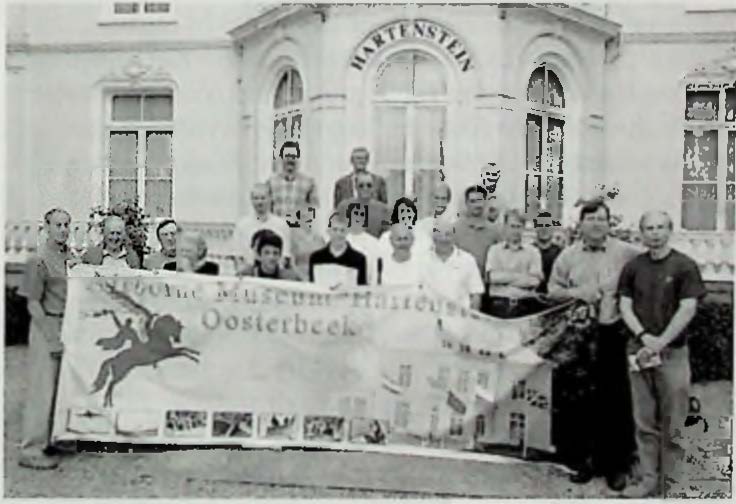 Participants in the ‘British Weekend’ of 22 to 24 lune 2001 pose in front of the Airborne Museum.
Participants in the ‘British Weekend’ of 22 to 24 lune 2001 pose in front of the Airborne Museum.
(Photo 23 June 2001: Berry de Reus)
‘British weekend’ 2003
I would like to thank everyone, the Dutch organisers as well as the group members, for their participation in the ‘British weekend’. A further battlefield tour with an entirely different programme will be prepared for 2003. Anyone who is interested, and perhaps has ideas or suggestions for the make-up of the programme, can get in touch with me.
(Niall Cherry)
Excursion in the Nijmegen area
On Saturday October 6 next our society is organising a coach tour through the area around Nijmegen. Fifty-seven years ago this was the central section of the ‘Corridor’ and the operational area of the 82nd American Airborne Division. The excursion will be led by Jacques Haegens. Marcel Anker will provide an informative explanation at the last point.
The programme will be largely as follows: 09.00 hours: Departure by coach from the Goede Herderkerk car park in Oosterbeek (east of the Airborne Museum) to Grave, where the actual excursion will begin. We go via the Maas bridge to the landing zones at Overasselt to visit the (former) canal lock bridge in Heumen, and the place where the 82nd American Airborne Division’s temporary cemetery was located. Following this we will take a look at a number of sites on the landing zones, such as the 508th Regiment’s DZ and the ‘De Bruuk’ area where Lieutenant General Frederick A. M. Browning landed with his headquarters (1st Airborne Corps). We will also visit the spot in the woods behind the Wolfsberg hotel where Brigadier General James M. Gavin (commander of the 82nd) had his HQ. Approximately 13.00 hours: LUNCH at the ‘Oude Molen’ in Groesbeek.
14.00 hours: Depart for Nijmegen. Visit to the Canadian Cemetery. Via Sionshof, we pass the school building in Heyendaalseweg that served as a reception point for some of the Airborne soldiers who withdrew from Oosterbeek on 26 September 1944. We then go to the Waalkade via Keizer Karelplein, Oranjesingel and Valkhof. From here one has an excellent overview of the Waal bridge.
Next stop the NUON office at the power generating station by way of the Hezelpoort and Waterkwartier. From the roof we have a magnificent view of the point where, on 20 September 1944, Major J Lilian Cook crossed the Waal with the 3rd Battalion, 504th Regiment, in the face of withering German fire. Price of participation is 65 guilders per person, which includes the coach trip, lunch and an excursion guide. This sum must be paid by 27 September next at the latest, mentioning ‘Corridor Excursion’. Booking applications will be dealt with in order of receipt. There is a maximum of 47 seats available; you will be notified on payment if you are one of the unlucky ones.
in July 1943. Admission is free, but because of the limited space available (seating for approx. 60), anyone wishing to attend is kindly requested to put forward his/her name before 27 September to Eugene Wijnhoud, Bernhardlaan 41-1, 6824 LE Arnhem, telephone 026 3513100; e-mail F.Wiinhoud@12move.nl.
Theme Afternoon, 3 November 2001
Our society is organising a theme afternoon on
3 November 2001. It will be held in Zalencentrum ‘Lebret’, Lebretweg, Oosterbeek.
The programme is as follows:
13.30 – 14.00 hours: Welcoming of members.
14.00 – 15.00 hours: Slide-illustrated lecture by Patrick Pronk on the 9lh (Airborne) Field Company Royal Engineers. Patrick is the author of the book ‘Airborne Engineers, The Shiny 9″’, an illustrated history of the 9th (Airborne) Field Company Royal Engineers 1939-1945’, published this year.
15.00 – 15.45 hours: INTERVAL.
15.45 – 16.30 hours: Showing of a film about the Battle of Arnhem.
17.00 hours (approx.): End of theme afternoon.
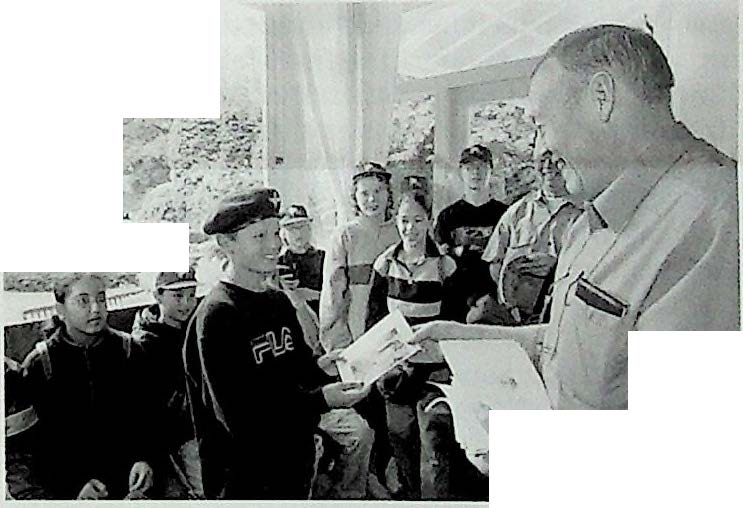 On Hie 22 lune 200’1, the 50,000th student visited the Airborne Museum within the cadre of the Schools Project. He received a number of presents from the hands of Society Chairman Chris van Roekel as reminders of this day.
On Hie 22 lune 200’1, the 50,000th student visited the Airborne Museum within the cadre of the Schools Project. He received a number of presents from the hands of Society Chairman Chris van Roekel as reminders of this day.
(Photo: Berry de Reus)
Lecture on The Border Regiment
On Sunday afternoon 7 October next, the curator of ‘The Border Regiment and King’s Own Royal Border Regiment Museum’ at Carlisle Castle, Mr Stuart Eastwood, will give a lecture at the Schoonoord restaurant (Pietersbergseweg 4) in Oosterbeek.
The lecture will begin at 14.00 hours. Mr Eastwood is co-author of the book ‘When Dragons Flew, an illustrated history of the 1st Battalion The Border Regiment 1939-1945′, published in 1994.
In his presentation, which will of course be in English, he will cover a number of aspects of the battalion’s history, including its involvement in Sicily Friday the 22nd of June 2001 was a special day for the Airborne Museum, for on that day the museum welcomed the 50,000th student to have visited the ‘Hartenstein’ in connection with the ‘Schools Project’. This project was developed 17 years ago by Chi is van Roekel on behalf of the Society of Friends with the aim of familiarising schoolchildren with the Battle of Arnhem in an educative and responsible manner. It is put together in such a way that teachers can tailor the subject to suit their personal teaching situation, and so provide the students with structured preparation prior to visiting the museum.
The entire project has been available on the internet for some time, from where it can be downloaded. The 50,000th student was Patrick Meijer, a pupil at Arendhorst primary school in Ermelo. Patrick was given VIP treatment together with some of his classmates, with Chairman Chris van Roekel in the role of host.
Frost’s hunting horn returned
The previous Newsletter was already at the printers when news came in that John Frost’s hunting horn, stolen from the Airborne Museum in August 1998, had been returned.
John Dutton Frost, born in 1912, followed his military training at Wellington and Sandhurst. He was attached to The Cameronians (Tire Scottish Rifles) and served in England and Palestine. In June 1938 he was seconded to the Iraq Levies, a unit made up of Assyrians, Kurds and Arab nomads. Their job was to guard RAF airfields and installations, and eventually keep open the supply lines to Jordan. Their base was an RAF airfield at Habbaniyah in present-day Iraq. As a captain, Frost had command of Landing Ground No. 5.
Tire British officers had formed a hunting club at the base called ‘The Royal Exodus Hunt’. In 1940, after two years service in the Middle East, Frost’s secondment came to an end and he was transferred back to England in December of that year. At his farewell party the members of the hunting club gave Frost a copper hunting-horn with silver mouthpiece. The horn is engraved as follows: ‘Capt. J.D. Frost, with best wishes from the members of the Royal Exodus Hunt’. In his book ‘A Drop too Many’ Frost describes the hunting-horn as ‘One of the best presents I have ever received’. On returning to England he rejoined his old regiment, The Cameronians (The Scottish Rifles), for a short period, after which he volunteered for the newly-formed Parachute Regiment. On 27 February 1942 he led the attack on a German radar station at Bruneval on the north coast of France. After this, as commander of the 2nd Parachute Battalion, he took part in the fighting in North Africa. On landing at Oudna in Tunisia on 29 December 1942, Frost used his hunting-horn to let his troops know where he was: ‘Having landed, 1 made for a small mound at the edge of the dropping-zone and sounded a note or two on my hunting-horn (the one which 1 had been given when 1 left Habbaniyah) to let people know where I was.’
Frost landed with his battalion at Wolfheze on 17 September 1944. Here, too, he used his hunting-horn to call his troops together. He was wounded during the fighting at the Rhine bridge and was taken prisoner by the Germans. At this point he lost his hunting-horn.
In July 1945, Mr E. R. Oosterwijk, as member of the Nijmegen Air Defence Service, was supervising the clearance work at the Rhine bridge in Arnhem. While a lorry was being loaded with rubble he noticed something glinting in the sun among the bricks.
On picking it up he saw that it was a dented hunting-horn. Oosterwijk took the object home, cleaned it up and managed to beat out some of the dent.
He saw an inscription on the horn from which it appeared that it had belonged to Captain J. D. Frost. He kept the horn at home for many years, but in September 1997 he contacted the Airborne Museum. He had decided to present this exceptional item to the museum, where it was exhibited in the ‘new acquisitions’ display cabinet.
During the night of 13/14 August 1998, the museum curator was awoken by the sound of the burglar alarm. The museum had been broken into and the hunting-horn stolen. Despite intensive investigations the horn remained Tost without trace’ for more than two and a half years. At some point an inhabitant of Arnhem tracked down the whereabouts of the horn, and thanks to his mediation this priceless treasure was eventually returned to the Airborne Museum at the end of May this year.
(W. Boersma)
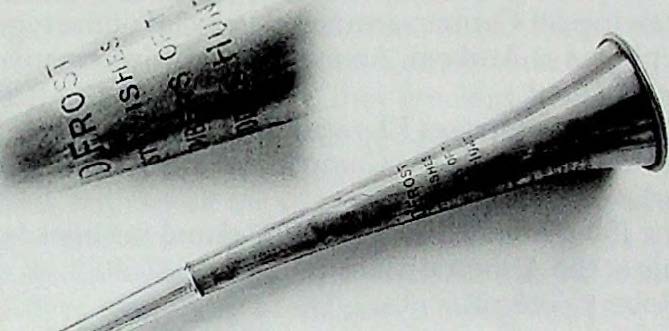 Frost’s recently returned engraved hunting-horn.
Frost’s recently returned engraved hunting-horn.
(Photo: Berry de Reus)
‘Old soldiers never die’
From 7 September to 4 November 2001 inclusive, the Airborne Museum will be holding an exhibition of portrait photographs of British veterans under the title ‘Old soldiers never die’. The photographs were taken by Pirn Limbeek from Veenendaal. Some years ago, during the commemorations of the Battle of Arnhem, Pirn was struck by the characteristic faces of the veterans. It was the annual parachute drop at Ginkel Heath near Ede in particular that gave him the opportunity of recording these faces on film.
Over the years this has led to an impressive archive of portrait photos. Limbeek began looking for somewhere to exhibit his photographs in September so that veterans and other interested parties might become familiar with his work. The Airborne Museum has now provided him with the chance to do this and more than thirty photographs will be on display. Not all the names of the veterans depicted are known to the photographer, so should any visitor recognise a face (or faces), he/she is kindly asked to complete a name-card.
‘German Armored Units at Arnhem’
A new title, ‘German Armored Units at Arnhem, September 1944′, has recently been added to the ever-growing list of books about the Battle of Arnhem. The book was compiled by society member Marcel Zwarts. Marcel is an expert in the field of German armoured vehicles, and through the years he has assembled an extensive collection of photos and information. Most of the photographs from his collection showing vehicles that took part in the Battle of Arnhem, 166 in all, are reproduced in his book. Many are previously unpublished.
The vehicles illustrated are first arranged per unit and then by time and place. The photos were shot in 1944 and 1945.
The captions, which contain many technical details of the vehicles shown, bear witness to Marcel’s encyclopaedic knowledge of the subject. In addition to the photographs there are sixteen beautiful colour drawings of German armoured vehicles of the types deployed at Arnhem. An exceptionally informative publication!
The book comprises 72 pages and is published by the Concord Publications Company of Hong Kong in the series ‘Armor at War’.
The ISBN number is 962-361-691-0 and the book is on sale at the Airborne Museum, price f 37.50.
(Robert Voskuil)
‘Battlefields of the Second World War’
Battlefield tourism is no new phenomenon. Thousands of people had already begun visiting the battlefields of Belgium and northern France shortly after the First World War ended, hr England it was Major and Mrs Holt who, in the seventies, introduced a commercial approach to battlefield trips throughout the entire world. Many tour operators have since followed their lead.
The BBC locked onto this trend with a series of broadcasts on First World War battlefields. This was followed by a series on the Second World War. Richard Holmes, professor in ‘Military and Security Studies’ at Cranfield University and the Royal Military College of Science, presents the broadcasts. This autumn, attention will be focused on the fighting at El Alamein, Monte Cassino and during Operation Market Garden, as well as on the Royal Air Force’s bombing of Germany. The book accompanying this series, also written by Richard Holmes, appeared recently under the title ‘Battlefields of the Second World War’.
We shall limit ourselves to the chapter on Operation Market Garden, which occupies 40 of the 224 pages. There are no really new facts, but that is hardly surprising. However, Holmes does examine in detail the controversy between the various allied commanders. The choice of these commanders is also discussed, and in this Field Marshal Montgomery is not spared. The radio communications, giound-to-air communications, Browning’s headquarters, the unexpected strength of the German troops and General Sosabowski are also reviewed. Neither do the ignoring of the information provided by the Dutch Resistance and the problems for the ground forces caused by the narrow advance route escape , attention. Wide coverage is given to the Americans’ successful efforts in the south.
It is difficult to make a summary because much is dealt with in few words, and that is precisely the chapter’s strong point. Despite the limited space, Holmes provides an excellent analysis of the operation. The description of the actual tour of the battlefield confines itself in general to a number of bridges, from the Joe Mansbrug over the Maas-Scheldecanal to the bridge in Arnhem, plus visits to the Airborne Museum, the landing zones and the Airborne Cemetery. The book is not intended as a true battlefield guide; John Waddy’s book ‘A Tour of the Arnhem Battlefield’ is much more appropriate.
The publication is clearly written but unfortunately it contains a few irritating errors. For example, it is incorrect that the Dutch Resistance made it possible for the port of Antwerp to fall undamaged into allied hands. This honour goes to the Resistance Movement of our southern neighbours.
‘Battlefields of the Second World War’ by Richard Holmes contains 224 pages, is illustrated with photographs and maps, and is published by BBC Worldwide Limited, Woodlands, 80 Woodland Lane, London W12 OTT, (ISBN 0-563-53782-5).
The book costs £ 17.99.
(W. Boersma)
Pegasus Walk
This year’s Pegasus Walk, the 18th, will take place on 22 October. The greater part of this journey follows the route taken by operation Pegasus 1 during the night of 22/23 October 1944. In this operation a substantial number of allied servicemen succeeded in crossing back over the Rhine with the help of the Dutch Resistance. They were then taken to the liberated area of the Netherlands.
For information and registration ring the VW: 0318 614444.
Messages from our UK representative
To all interested UK members.
Copies of the books ‘Airborne Engineers’ and ‘The Torn Horizon’ are available from me, price £ 10 plus £1 p&p.
1 would be pleased to hear from any of our UK-based members who might have information, stories etc that could be suitable for inclusion in the Newsletter and/or Ministory.
(Niall Cherry)

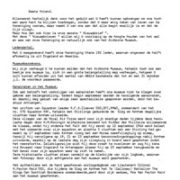
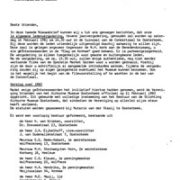
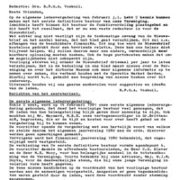
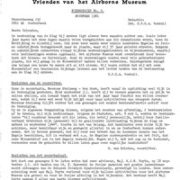
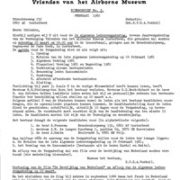
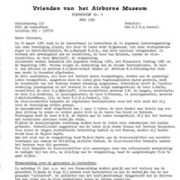
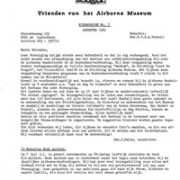
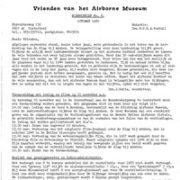
Plaats een Reactie
Vraag of reactie?Laat hier uw reactie achter.